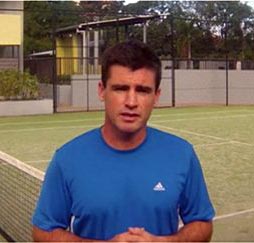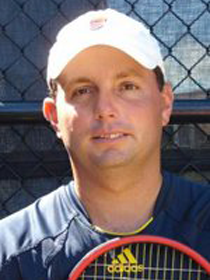|
TennisOne Lessons Novak Djokovic: Number One and Having Fun Tom Downs Novak Djokovic recently won his second Wimbledon singles title defeating Roger Federer in five grueling sets. I remember looking at some interesting statistics before the final, which showed from 2008-2010 Djokovic had a winning percentage of 79% in grand slam and ATP 1000 events. Since 2011 this percentage has increased to 90%. While these statistics show great improvement, the thing that most captured my attention was his numbers against Roger Federer, Rafael Nadal, and Andy Murray, which to me reveals an even more important story. From 2008-2010 Djokovic was 1-3 vs. Murray, 5-10 vs. Nadal and 5-8 vs. Federer. From 2011-until the present he is 8-5 vs. Murray, 12-7 vs. Nadal and 12-5 vs. Federer. He has increased his winning percentage against these great players from 34% from 2008-2010 to 65% there after.
Djokovic's gluten free diet has been well documented, but to complete this impressive turn-around he had to make some changes to his game. Lets take a look at the three areas of his game that he has improved the most and some specific drills club players can do to improve their own games in these same areas. Work on Your Weaknesses Novak Djokovic struggled with his serve during the 2010 season. He changed motions several times but eventually his long time coach, Marian Vajda, suggested he use a motion that felt more natural. While struggling with his serve, and throughout his career, Djokovic had brought in experts to help him with certain parts of his game. For instance, the great Aussie doubles specialist, Mark Woodforde, had been brought in to help with his transition game and his volleys. Former world number four, Todd Martin, was brought on board for several reasons, but specifically to help with the serve. Eventually, after struggling to come up with a motion that was more effective, he settled on a motion that felt comfortable and natural and it was vastly similar to his original motion. He restored the technique on his serve and along with that he was able to redevelop trust in his ability to hit it under pressure.
The lesson for club players here is the importance of developing fundamentally sound technique as a foundation for mental toughness. I have also found the serve to be a very personal thing to a large extent. While the fundamentals all have to exist, I have never seen two serves that have identical form. Everyone's rhythm is different. Finding the right rhythm for you is key. One of the best drills for working on the serve is to create a scenario for yourself on the practice court. Pretend you're in the finals of your local tournament, down a break point deep in the third set and you have to hit a second serve". Go through your routine and then execute a second serve. Do this for 15 minutes during your serving sessions and see how many times your second serve is successful.. Next, practice serve at targets and use the same routine for every serve — same amount of balls, arms separate at the same speed, basically everything should feel exactly the same for every serve. If you're having problems with the serve, seek advice from a coach you trust and commit to making changes and fix it. Vajda solved the problem for Novak by simply getting him to use a motion that felt natural. Djokovic may not serve as well as some of the other top players, however, his serve is extremely efficient and the best he can do. Improved Responses to Difficult Internal Experiences
According to renowned ATP coach and tennis psychologist, Anthony Ross, "The most common reason for a player's mental weakness is subconscious attempts to reduce fear." Tanking, anger, excuses (without realizing it) — these are often driven by fear reduction properties. I believe Djokovic suffered early career stumbles against the elite players due to an inability to handle the stress of pressure moments. But, as I mentioned earlier, his statistics against the top three players have greatly improved over the last few years. This is largely due to his ability to handle pressure situations so much more efficiently. We hear much about Novak's diet, but surprisingly, we hear very little about his "mindfulness" — in other words, his approach to the mental side of the game. In his book, Serve to Win, he had this to say, "I do it everyday for about 15 minutes and it is as important to me as my physical training…Instead of trying to silence your mind or find inner peace, you allow and accept your thoughts as they come. They do bounce around like crazy, but they are supposed to. Your job is to let them come and go." He further goes on to say that he has reaped the benefits, "I've done so much mindfulness that my brain functions now automatically. I used to freeze up whenever I made a mistake. Now when I blow a serve or shank a backhand I still get those flashes of self doubt but I know how to handle them." So when Novak was facing difficult situations in his fourth and fifth sets against Federer, with all sorts of challenging thoughts racing through his head, all the work he had put into his mindfulness training really paid off. So take a leaf out of Novak's book and spend 15 minutes a day off the court dedicating yourself to improving your mindfulness. And instead of trying to quiet the mind, learn to accept the chaos and let it go.
Improve Your Strengths As I mentioned earlier, Djokovic has improved his serve greatly, but he has also improved his tactics and overall style of play. He hits his down-the-line backhand better than just about anyone on the tour, he transitions to his forehand after the serve to immediately take control of a point, he opens the court with wide serves and well placed groundstrokes much better than in his earlier years, and he moves forwards and finishes points efficiently at net. When he first came on tour, Djokovic had a tendency to play little passively, but now he has a broad range of shots that are all very dependable including a competent slice backhand and drop shot off the backhand wing. The lesson here is to never become complacent with success. Continue to work on and improve all aspects of your game. If you have a two-handed backhand, work on the the slice backhand and add it to your repertoire (I believe everyone should have one). The pros make everything look easy, even when they are forced into uncomfortable positions. Push yourself in practice — emulate the pros and try to get comfortable being uncomfortable. Work on developing an all court game. Mix up your drills and keep your practice sessions exciting. This is a great way to gain improvement and maintain enjoyment at the same time. I think tennis would be a boring game if we had nothing to improve. So remember, everything can always get better.
Your comments are welcome. Let us know what you think about Tom Downs' article by emailing us here at TennisOne.
Tom has and extensive coaching background, and has been a member of the Institute team for several years. He has served as our Head Staff Professional, and is currently the Traveling Coach for Institute players. He has traveled with several of our Tour players including Laura Granville and Carly Gullickson, who won the US Open Mixed Doubles title in 2009. Tom has worked with junior and other professional players, including Sam Stosur and Rennae Stubbs, at all 4 Grand Slam events, as well as other major tournaments around the world. Tom graduated from the University of South Florida in 2005 with a degree in communications. As a successful junior player, Tom represented Australia, and was consistently ranked in the top 10 in all age groups in Australia. He played college tennis at South Carolina State University and was a member of their conference championship team in 2004. |

 Tom Downs
Tom Downs